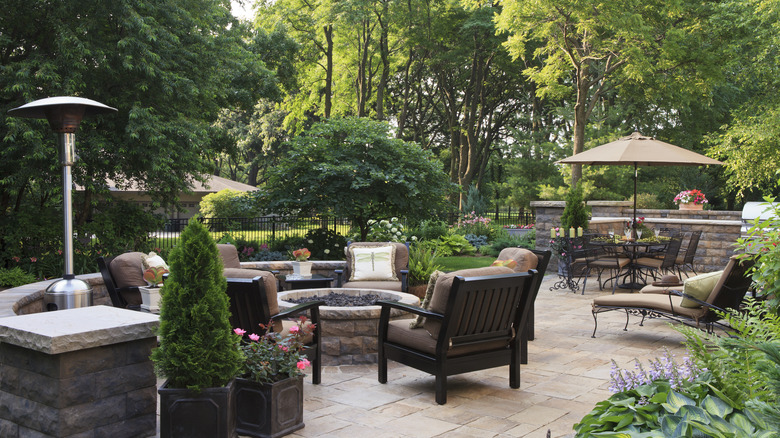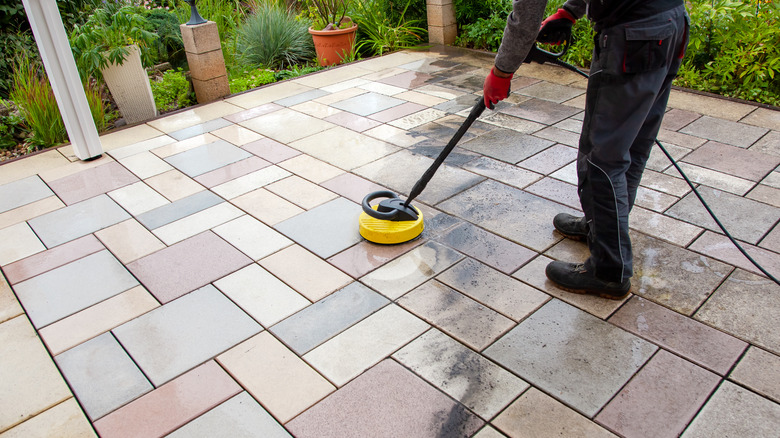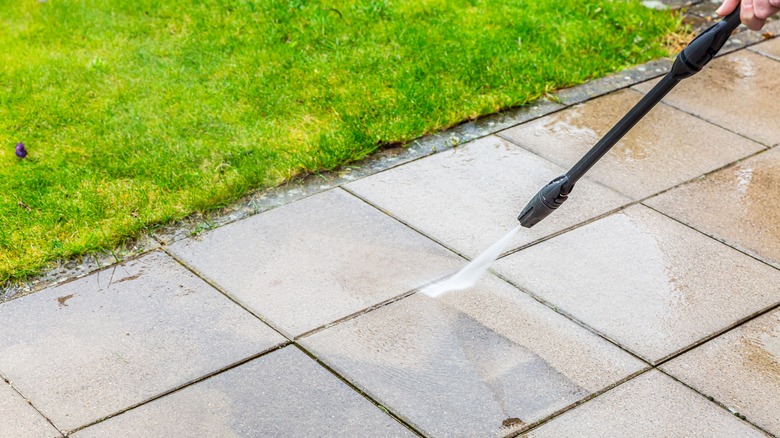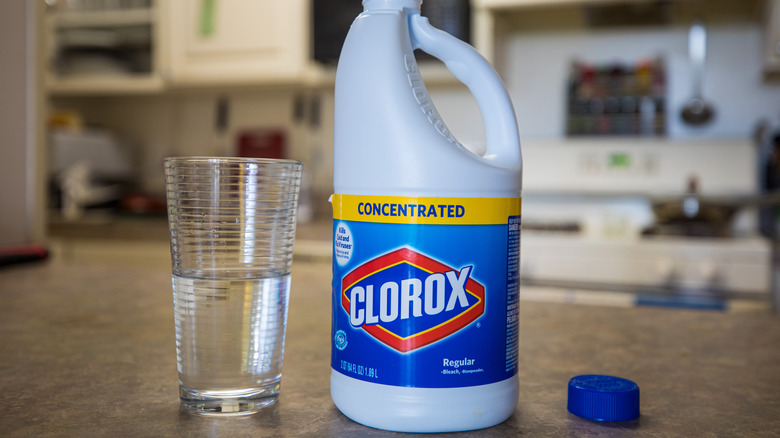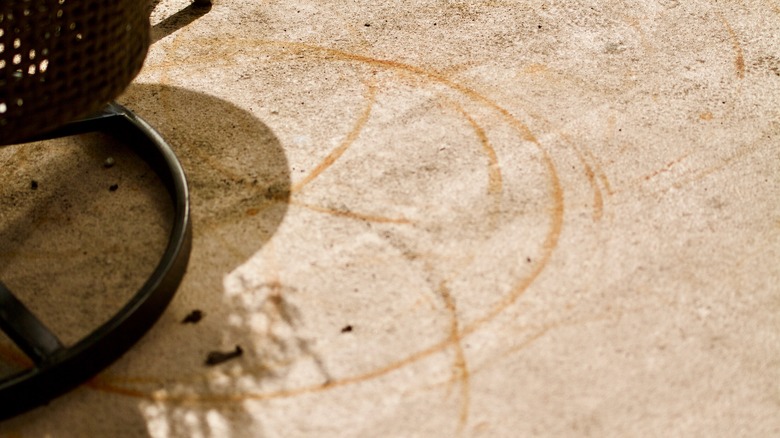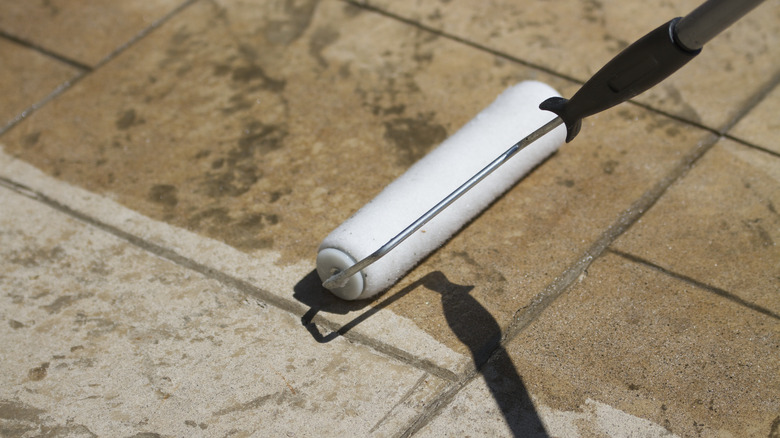These Cleaning Mistakes Are Damaging Your Patio
We may receive a commission on purchases made from links.
If designed correctly, patios are often seen as extended indoor living spaces. They act like second living or dining rooms and offer an extra space to gather and relax. They can have everything from expansive outdoor dining tables to comfy couches to outdoor fireplaces, encouraging you to spend some of your downtime outside. Because of this, it's imperative to many people that they keep their patio floors clean and blemish-free. But that's easier said than done. Heavy rain can create grime buildup, and nearby grass can create muddy edges or dirt stains. Outdoor rugs can cause discoloration, and metal furniture can develop rust stains. All these scenarios will lead you to reach for a bucket and scrub brush, but sometimes cleaning pavers isn't as straightforward as we think. There are a series of cleaning mistakes that can harm your patio rather than restore it to its natural beauty.
These mistakes span across a spectrum, with some being less troublesome than others. For instance, not cleaning up spills as soon as they happen can lead to trickier stains to clean. This isn't as serious as using a pressure washer without much experience, which can lead to permanent streaks or chips in your paver stones. However, it's best to avoid both scenarios, so it's important to be aware of the potential pitfalls. Ahead are all the cleaning mistakes you can potentially make that will harm the appearance of your patio.
Using vinegar to clean your patio
Vinegar is a staple in most people's cleaning arsenals, and for good reason. Acetic acid is vinegar's main component, and distilled white vinegar contains about 5 percent of the acid. This makes it strong enough to lift stubborn stains, which is why you might be tempted to use it on your patio. After all, your patio is constantly exposed to rain, snow, and debris, and that could leave unsightly marks and discoloration on the stone. However, you might want to think twice before using vinegar to clean your pavers. That same acid could eat away at the natural stone, damaging your setup.
Whether your patio is made of natural stone tiles like limestone ,uses a patchwork of terrazzo pieces, or is poured concrete, the results are the same: Vinegar can eat away at it. It will create small pits in the stone, which are the pockets left over after it dissolves the material. Cass Heaphy, Digital Director at Paving Direct, confirmed this issue to the Daily Express: "Limestone, sandstone and Portland cement concrete are all vulnerable to chemical erosion and corrosive damage from acids, so any acid-based liquid will partially corrode and damage the stone/concrete of the patio." To stay on the safe side, use an alkaline patio cleaner instead, such as Stain Proof Alkaline Cleaner, which retails for $19 on Amazon.
Using a pressure washer
Pressure washers are a go-to for many stubborn cleaning jobs, so you might be tempted to blast away any mildew or discoloration with the high-powered hose. However, a downside to using a pressure washer to clean your patio is that it can crack or etch the pavers if you're not careful. It can also discolor the surface in the form of streaks, which appear if you hold the tool too close to the surface. It can also wear away the protective finish on top of the pavers if the pressure is too high. While you can technically use a pressure washer to clean them, you have to do so carefully to avoid these issues.
If you're not confident with your pressure washing skills, it's best to skip this cleaning method and instead hire a professional to do it for you. On average, this service costs $250, but it depends on how big your patio is. The more square footage, the higher the quote. If you are relatively skilled in using a pressure washer, then remember to use it on the lowest setting to protect the pavers. You can increase the pressure if you hit a particularly dirty spot, but do so slowly and with caution, as this can permanently damage the stone.
Using bleach to remove buildup
Bleach can be a tempting go-to solution to wipe away any mold, algae, or weeds growing on or in between your patio pavers, and while it works, it should be used with caution. First, you want to make sure it's not too concentrated, or else it can discolor the pavers. To dilute it, add no more than 1/3 cup of bleach to 1 gallon of water. However, since you have to leave it on the patio for six minutes in order for the bleach to work its magic, the stone can appear fadedin places if the substance begins to eat away at the stone. Because of this, there is a risk to using this cleaning method.
There is also an environmental risk to using bleach on your patio. Since you need to rinse the solution off its surface, runoff will spill into your surrounding grass or plants. Repeated use will eventually kill that surrounding vegetation. However, a workaround to this predicament is to use oxygen bleach rather than chlorine bleach. That's because it's a natural product made from hydrogen peroxide and sodium carbonate. It uses oxygen ions to scrub dirt and remove buildup and is nontoxic.
Not cleaning marks as soon as they happen
Patios get a lot of wear and tear due to their exposure to the outdoor elements. Planters and metal chairs can leave behind rust marks, dirt stains from grass can leave behind dark, murky splotches, and food spills from the patio table or barbecue section can leave behind slight discoloration. These can be relatively simple to remedy if you clean them immediately, but they become trickier to eradicate if you let them set. That's because many patio pavers are porous, and the stain can settle deep into the stone.
To clean up these messes, always wet the stain first to loosen the grime, dirt, or buildup. Then grab a bucket of warm water with a few drops of dishwashing soap and a stiff bristle brush. That's all you really need for most stains, and the dish soap is gentle enough that it won't harm the top sealant or cause any etching or discoloration. However, make sure you don't use anything rougher than a hard bristle brush. For instance, steel wool pads can scratch the stone and leave behind marks. While dish soap shouldn't be fatal to nearby vegetation, you want to make sure you're not allowing copious amounts of runoff to spill into the surrounding grass or nearby flower beds. If you need to clean a spot close to the grass, you can try using a plant-based formula, like Ecover Dish Soap, retailing for just under $10 on Amazon.
Not sealing the patio afterwards
After deep cleaning your patio, you might think your job is done after you rinse off the cleaning agents and allow the area to air dry. But there is one more step to the process: sealing the pavers. Doing so has many benefits. Continual cleaning — especially with harsher methods, such as power washers and bleach — can strip away the protective coating on top of your patio. By resealing them after a deep clean, you ensure your patio will be safe from weather damage, color fading, staining, and being overrun by weeds. You only need to do this once every several years.
However, not just any sealant will do. Different materials require different topcoats. For example, concrete, brick, and clay pavers need a paving stone sealer, such as Seal King's Paving Stone Sealer. These are known as film-forming sealants, and they create a protective, invisible layer on top that protects the pavers from daily wear and tear. On the other hand, natural stone pavers such as limestone or sandstone require natural stone sealers, such as Rainguard Water Sealer's Stone Sealer for $18.99. These are penetrating sealants, which soak into the stone rather than creating a thick barrier on top that would lock in moisture. This is important because it allows the stone to breathe, preventing it from crumbling.
